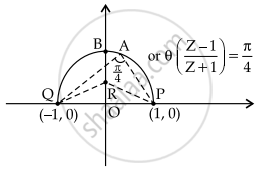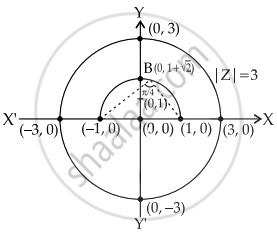Advertisements
Advertisements
प्रश्न
Let arg (z) represent the principal argument of the complex number z. Then, |z| = 3 and arg (z – 1) – arg (z + 1) = `π/4`intersect ______.
पर्याय
Exactly at one point.
Exactly at two points.
Nowhere
At infinitely many points.
उत्तर
Let arg (z) represent the principal argument of the complex number z. Then, |z| = 3 and arg (z – 1) – arg (z + 1) = `π/4`intersect nowhere.
Explanation:
Given: |z| = 3
⇒ It represents a circle of radius 3 and centre at (0, 0)
And arg (z – 1) – arg (z + 1) = `π/4`
⇒ agr`((z - 1)/(z + 1)) = π/4`
⇒ z is on major are of circle having PQ as chord and R(0, a) as centre of the circle.

So, ∠PAQ = ∠ORP = `π/4`
⇒ OP = OR = a = 1
∴ Coordinates of R is (0,1)
So, radius = RP = `sqrt(2)`
∴ OB = OR + `sqrt(2) = 1 + sqrt(2)`
⇒ B = `(0, 1 + sqrt(2))`

So, it is clear from the figure, both curves do not intersect.
∴ No z satisfy both equation.
